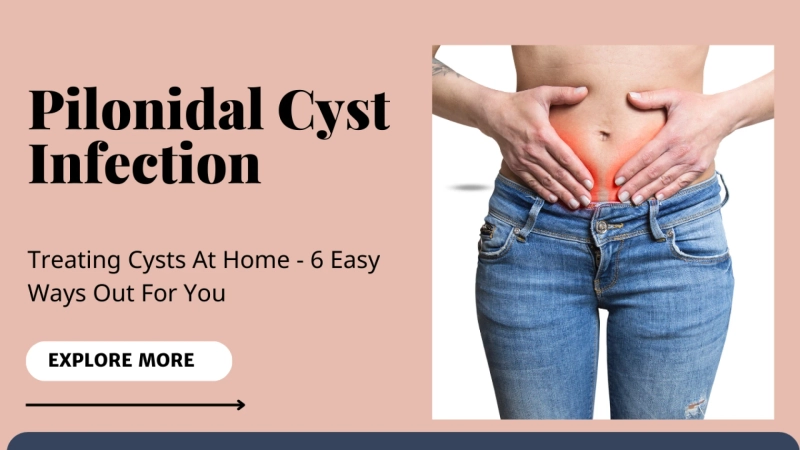Pilonidal cyst infection is a skin infection which develops when debris and hair follicles become imprisoned in the epidermis. This results in the growth of a tiny cyst or abscess. Men are more likely than women to have the illness, which mainly affects persons between the ages of 15 and 40.
A pilonidal cyst's earliest signs and symptoms include localized pain, swelling, and redness. A pus-filled abscess may form when the cyst enlarges and become more uncomfortable. Occasionally, an abscess may burst, releasing a foul-smelling fluid. Moreover, the area may become painful and itching, and in more serious cases, fever and nausea may develop.
There are a number of things that can make you more likely to get one. They include being overweight, spending a lot of time sitting down, and excessive perspiration. The condition's emergence may also be influenced by genetics.
Pilonidal cysts are normally treated by draining the abscess and getting rid of any hair or debris lodged inside the cyst. Under local or general anesthesia, this can be carried out in a medical office or a hospital setting. Antibiotics may also be prescribed in specific circumstances to stop the spread of infection.
Surgical intervention can be required if the issue worsens or reappears. The removal of the cyst and the surrounding tissue, known as a pilonidal cystectomy, is one surgical option for pilonidal cysts. Another option is the use of a flap technique, in which healthy tissue is used to cover the affected area.
Maintaining proper hygiene, avoiding extended sitting, and keeping the area dry and clean are all important in preventing pilonidal cysts. Moreover, avoiding tight clothing and donning loose-fitting clothing can help lower the likelihood of acquiring the illness.
Pilonidal cyst signs and symptoms
Pain in the buttocks, tailbone, or lower back.A little crease or indentation at the spine's base in the skin.Swelling, redness, or discomfort around the cyst.Discharge of blood or pus from the cyst.Release coming from the cyst that smells bad.In the affected area, there may be itching or irritation.Fever or other infection-related symptoms (in more severe cases).What to do if a pilonidal cyst is infected?
A pilonidal cyst is a pocket or a tissue sac located at the base of the tailbone, which can cause pain and discomfort if it becomes infected. Here are several things you can do if you suspect that your pilonidal cyst is infected:
See a healthcare provider
If you notice any signs of pilonidal cyst infection, such as redness, swelling, warmth around the cyst, fever, or pus drainage, it's essential to seek medical attention. Your healthcare provider can evaluate the severity of the infection and suggest the appropriate treatment.
Practice good hygiene
Keeping the affected area clean and dry is essential to prevent further infection. You can use mild soap and water to clean the area and avoid tight-fitting clothing or sitting for prolonged periods. It is essential to maintain good hygiene not only to prevent pilonidal cyst infections but also to keep your body fit and healthy.
Avoid popping or squeezing the cyst
It may be tempting to try to pop or squeeze the cyst to drain the pus. However, this can worsen the infection and lead to further complications.
Maintain a healthy lifestyle
Maintaining a healthy lifestyle can help prevent pilonidal cysts from developing and reduce the risk of infection.
Wear loose-fitting clothing
Tight-fitting clothing can increase pressure on the tailbone area, exacerbating pilonidal cysts and infections. Wearing loose-fitting clothing can help reduce anxiety and improve airflow to the affected area.
Consider preventive surgery
If you have a recurrent pilonidal cyst infection or are at high risk for developing them, your healthcare provider may recommend prophylactic surgery. This can involve removing the affected tissue or reconstructing the area to reduce the risk of future cysts and infections.
Quit smoking
Smoking is a detrimental activity which overall hampers your lifestyle. It reduces your body's strength and affects your overall immunity. This hinders your body's ability to fight pilonidal cyst infection
Do stress reduction
Try doing stress-reducing practices like yoga. You can also breathe in certain patterns like deep breathing practices. This helps your body cool down and fight better against any potential infections.
Elevate the injured area
Elevating the injured area can assist in lessening pain and oedema. To lift the cyst above your heart level, you can try putting a pillow or cushion under your buttocks.
Take over-the-counter pain relievers
Acetaminophen or ibuprofen, for example, can help reduce the pain and discomfort brought on by the infection. But it's crucial to consult your doctor before taking any medicine, especially if you're also taking another one.
Conclusion
A pilonidal cyst infection can be an extremely painful situation. However, in certain cases, very few of its symptoms prop up, and it can be negligible in nature. Getting medical attention, maintaining good cleanliness, using painkillers as needed, and following up with your healthcare practitioner are critical to guarantee appropriate healing. You can prevent future cysts by leading a healthy lifestyle, managing stress, and taking preventive actions like laser hair removal or surgery.


